
Intel High Definition Audio (IHDA) (also called HD Audio or development codename Azalia) is a specification for the audio sub-system of personal computers. It was released by Intel in 2004 as the successor to their AC'97 PC audio standard. [1]

Intel High Definition Audio (IHDA) (also called HD Audio or development codename Azalia) is a specification for the audio sub-system of personal computers. It was released by Intel in 2004 as the successor to their AC'97 PC audio standard. [1]
The Intel High Definition Audio specification includes the following features: [2]
Motherboards typically do not have any more than eight built-in output channels (7.1 surround sound) and four input channels (back and front panel microphone inputs, and a back-panel stereo line-in). Users requiring more audio I/Os will typically opt for a sound card or an external audio interface, as these provide additional features that are more oriented towards professional audio applications.
The Service Pack 3 update to Windows XP and all later versions of Windows (from Vista onwards) included the Universal Audio Architecture (UAA) class driver, which supported audio devices built to HD Audio's specifications. Retrospective UAA drivers were also built for Windows 2000, Server 2003 and XP Service Pack 1/2. [3] macOS provides support for Intel HD Audio with its AppleHDA driver. Several Linux operating systems also support HD Audio, as well as OpenSolaris, [4] FreeBSD, [5] and OpenBSD. [6]
Like AC'97, HD Audio acts as a device driver, defining the architecture, link frame format, and programming interfaces used in the hardware of the host controller of the PCI bus and linking it to a codec used by a computer's software. [7] Configurations of the host controller (Chipset) are available from third-party suppliers, including Nvidia, VIA and AMD, [7] while codecs have also been provided by third-party suppliers including Realtek, Conexant, IDT, VIA, SigmaTel, Analog Devices, C-Media and Cirrus Logic. [8] [9] AMD's TRX40 chipset was introduced in 2019 for use with Ryzen "Threadripper" CPUs, which provided the Realtek ALC1220 chip instead of the HD Audio interface. As a result, a separate USB or PCIe audio device was required to integrate HD audio codecs on TRX40 motherboards. [10]
As with the previous AC'97 standard, HD Audio does not specify handlers for the media buttons attached to headphone jacks (i.e., Play/Pause, Next, Previous, Volume up, Volume down).[ citation needed ]
Computer motherboards often provide a connector to bring microphone and headphone signals to the computer's front panel. Intel provides a general specification for this process, but the signal assignments are different for both AC'97 and HD Audio headers. [11]
The pin assignments for the AC'97 and HD Audio connectors are: [11] : 21, 22
| Pin | AC'97 | HD Audio (HDA) | ||
|---|---|---|---|---|
| Signal | Description | Signal | Description | |
| 1 | MIC |
| PORT 1L | Audio, left, port 1 |
| 2 | AUD_GND | Ground | GND | Ground |
| 3 | MIC BIAS |
| PORT 1R | Audio, right, port 1 |
| 4 | AUD_GND | Ground | PRESENCE# | HDA dongle/connector detection, active low |
| 5 | FP_OUT_R | Audio out, right, out (headphone-level capable), front panel | PORT 2R | Audio, right, port 2 |
| 6 | FP_RETURN_R | Audio, right, return (when jack is unconnected), front panel | SENSE1_RETURN | Port 1 jack detection |
| 7 | AUD_5V | Power, +5 V | SENSE_SEND | Jack detection sense, resistance multiplexed |
| 8 | KEY | Not present, physical key | KEY | Not present, physical key |
| 9 | FP_OUT_L | Audio, left, out (headphone-level capable), front panel | PORT 2L | Audio, left, port 2 |
| 10 | FP_RETURN_L | Audio, left, return (when jack is unconnected), front panel | SENSE2_RETURN | Port 2 jack detection |
The HD Audio 3.5 mm subminiature audio jack differed from connectors used in the AC'97 specification and in general audio equipment. The AC'97 used a regular 3.5 mm audio jack, which typically has 5 pins: one pin for ground, two pins for stereo signal, and two pins for the return signal. [11] : 20 When no plug is connected, the two stereo signals are connected to their return pins. When a plug is inserted, the stereo signals contact the respective channels on the plug and are disconnected from the jack's return pins. The HD Audio 3.5 mm jack does not have the two return audio signals; instead, it has an isolated switch that senses the presence of a plug in the jack. [11] : 25
In the AC'97 design, the audio output is sent to the jack by default. When a headphone is detected, the return signal pins for the speakers are disconnected, directing the audio to the headphone. The jack redirects the audio to the speakers if no headphone connection is detected. Similarly, the return pins ground the microphone jack connection if no microphone detected. As a result, most motherboards with AC'97 audio require two jumpers to short these pins if no front panel audio module is connected, so audio passes to the speakers. [11] : 21
In the HD Audio design, the codec sends the audio directly to the speakers if a plug is not inserted. When a plug is inserted, the isolated switch inside the jack informs the motherboard, and the codec sends audio to the headphones. A similar isolated switch is used to detect when a microphone has been plugged in. HD Audio can also sense the presence of an audio dongle. A 10 kΩ pull-up resistor is attached to pin 4 (PRESENCE#). When the HDA dongle is plugged in, it pulls pin 4 to the ground with a 1 kΩ resistor. The motherboard can determine if a dongle is connected by examining the logic level on pin 4. If the motherboard does not detect a HDA dongle, it should ignore the SENSE1_RETURN (pin 6) and SENSE2_RETURN (pin 10) signals. [11] : 24
Intel warns that HDA dongles should be used with HDA motherboards: [11] : 19
It is strongly recommended that motherboard designers only use Intel HD Audio analog front panel dongles with the Intel HD Audio analog front panel header to ensure that the jack detection and dynamic retasking capability are preserved. Passive AC'97 analog front panel dongles (ones that leave the 5V Analog pin-7 line unconnected on the dongle) may be used with the Intel HD Audio analog front panel header. But note that the front panel jack detection and re-tasking functionality will be lost as the AC'97 jacks cannot support connection to the SENSE line. In addition, software must be aware that an AC'97 dongle is being used with an Intel HD Audio analog header since the software might need to dedicate codec ports that are connected to the header to meet the product's intended functionality.
The different signal assignments can cause trouble when AC'97 front-panel dongles are used with HDA motherboards and vice versa. An AC'97 dongle returns audio on pins 6 and 10 rather than digital plug sensing signals. Consequently, a loud audio passage may cause a HDA motherboard with a AC'97 dongle believe headphones and microphones are being plugged and unplugged hundreds of times per second. An AC'97 motherboard with an HDA dongle will route the AC'97 5 V audio supply (pin 7; silence) to the speakers instead of the desired left and right audio signals. To avoid this, some motherboards allow choosing between HDA and AC'97 front panels in the BIOS. Even though the actual audio hardware is HD Audio, the BIOS can be manipulated to allow the use of an AC'97 front panel. Likewise, some modern enclosures have both an "AC'97" and an "HDA" plug at the end of the front-panel audio cable.[ citation needed ]

A sound card is an internal expansion card that provides input and output of audio signals to and from a computer under the control of computer programs. The term sound card is also applied to external audio interfaces used for professional audio applications.
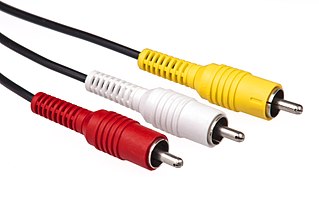
The RCA connector is a type of electrical connector commonly used to carry audio and video signals. The name RCA derives from the company Radio Corporation of America, which introduced the design in the 1930s. The connector’s male plug and female jack are called RCA plug and RCA jack.
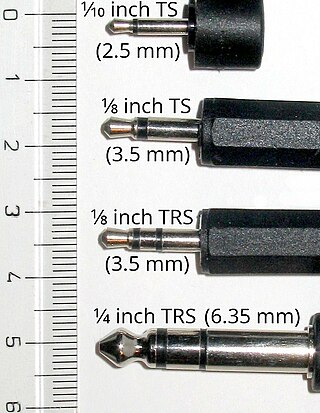
A phone connector is a family of cylindrically-shaped electrical connectors primarily for analog audio signals. Invented in the late 19th century for telephone switchboards, the phone connector remains in use for interfacing wired audio equipment, such as headphones, speakers, microphones, mixing consoles, and electronic musical instruments. A male connector, is mated into a female connector, though other terminology is used.
AC'97 is an audio codec standard developed by Intel Architecture Labs and various codec manufacturers in 1997. The standard was used in motherboards, modems, and sound cards.
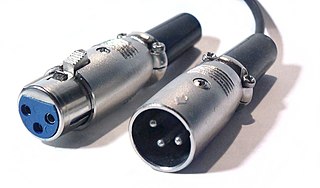
The XLR connector is a type of electrical connector primarily used in professional audio, video, and stage lighting equipment. XLR connectors are cylindrical in design, with three to seven connector pins, and are often employed for analog balanced audio interconnections, AES3 digital audio, portable intercom, DMX512 lighting control, and for low-voltage power supply. XLR connectors are included to the international standard for dimensions, IEC 61076-2-103. The XLR connector is superficially similar to the smaller DIN connector, with which it is physically incompatible.
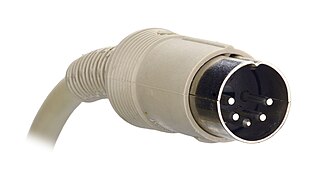
The DIN connector is an electrical connector that was standardized by the Deutsches Institut für Normung (DIN), the German Institute for Standards, in the mid 1950's, initial with 3 pins for mono, but when stereo connections and gear appeared in late 1950's, versions with 5 pins or more were launched. The male DIN connectors (plugs) feature a 13.2 mm diameter metal shield with a notch that limits the orientation in which plug and socket can mate. The range of DIN connectors, different only in the configuration of the pins, have been standardized as DIN 41524 / IEC/DIN EN 60130-9 ; DIN 45322 ; DIN 45329 / IEC/DIN EN 60130–9 ; and DIN 45326 / IEC/DIN EN 60130-9.

The southbridge is one of the two chips in the core logic chipset on older personal computer (PC) motherboards, the other being the northbridge. As of 2023, most personal computer devices no longer use a set of two chips, and instead have a single chip acting as the 'chipset', for example Intel's Z790 chipset.

In computer hardware, a CPU socket or CPU slot contains one or more mechanical components providing mechanical and electrical connections between a microprocessor and a printed circuit board (PCB). This allows for placing and replacing the central processing unit (CPU) without soldering.

SoundStorm is a brand by Nvidia regarding to a SIP block integrating 5.1 surround sound technology found on the die of their nForce and nForce2 chipsets for x86 CPUs. It is also the name of a certification to be obtained by Nvidia when complying with their specifications.
Conexant Systems, Inc. was an American-based software developer and fabless semiconductor company that developed technology for voice and audio processing, imaging and modems. The company began as a division of Rockwell International, before being spun off as a public company. Conexant itself then spun off several business units, creating independent public companies which included Skyworks Solutions and Mindspeed Technologies.
Communications and networking riser (CNR) is a slot found on certain PC motherboards and used for specialized networking, audio, and telephony equipment. A motherboard manufacturer can choose to provide audio, networking, or modem functionality in any combination on a CNR card. CNR slots were once commonly found on Pentium III-class motherboards, but have since been phased out in favor of on-board or embedded components.
Realtek Semiconductor Corp. is a fabless semiconductor company situated in the Hsinchu Science Park, Hsinchu, Taiwan. Realtek was founded in October 1987 and subsequently listed on the Taiwan Stock Exchange in 1998. Realtek currently manufactures and sells a variety of microchips globally and its product lines broadly fall into three categories: communications network ICs, computer peripheral ICs, and multimedia ICs. As of 2019, Realtek employs 5,000 people, of whom 78% work in research and development.
The mobile daughter card, also known as an MDC or CDC, is a notebook version of the AMR slot on the motherboard of a desktop computer. It is designed to interface with special Ethernet (EDC), modem (MDC) or bluetooth (BDC) cards.
Serial Digital Video Out (SDVO) is a proprietary Intel technology introduced with their 9xx-series of motherboard chipsets.
I/O Controller Hub (ICH) is a family of Intel southbridge microchips used to manage data communications between a CPU and a motherboard, specifically Intel chipsets based on the Intel Hub Architecture. It is designed to be paired with a second support chip known as a northbridge. As with any other southbridge, the ICH is used to connect and control peripheral devices.
Audio connectors and video connectors are electrical or optical connectors for carrying audio or video signals. Audio interfaces or video interfaces define physical parameters and interpretation of signals. For digital audio and digital video, this can be thought of as defining the physical layer, data link layer, and most or all of the application layer. For analog audio and analog video these functions are all represented in a single signal specification like NTSC or the direct speaker-driving signal of analog audio.
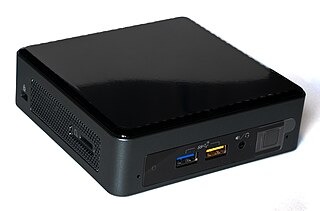
Next Unit of Computing (NUC) is a line of small-form-factor barebone computer kits designed by Intel. It was previewed in 2012 and launched in early 2013. The NUC has developed over ten generations, spanning from Sandy Bridge-based Celeron CPUs in the first generation through Ivy Bridge-based Core i3 and i5 CPUs in the second generation to Gemini Lake-based Pentium and Celeron CPUs and Kaby Lake-based Core i3, i5, and i7 CPUs in the seventh and eighth generations. The NUC motherboard usually measures approximately 10 × 10 centimetres (4 × 4 in), although some models have had different dimensions.
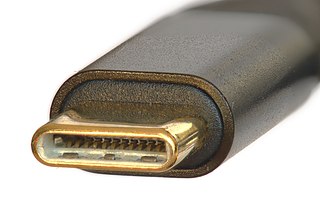
USB-C, or USB Type-C, is a 24-pin connector that supersedes previous USB connectors and can carry audio, video and other data, e.g., to drive multiple displays, to store a backup to an external drive. It can also provide and receive power, such as powering a laptop or a mobile phone. It is applied not only by USB technology, but also by other protocols, including Thunderbolt, PCIe, HDMI, DisplayPort, and others. It is extensible to support future standards.

On June 26, 2007, Dell released the new Inspiron desktop series, under the Dell Inspiron branding, as a replacement to the Dell Dimension desktop computers.

The Dell Inspiron series is a line of laptop computers made by American company Dell under the Dell Inspiron branding. The first Inspiron laptop model was introduced before 1999. Unlike the Dell Latitude line, which is aimed mostly at business/enterprise markets, Inspiron is a consumer-oriented line, often marketed towards individual customers as computers for everyday use.